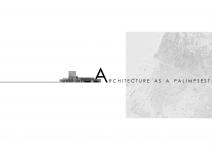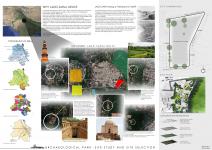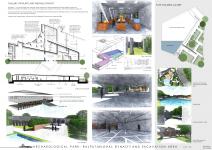How can Architecture be a Palimpsest?
We are all intrigued by buildings, landscapes, objects and the relationship between them, and also interesed in the transformative process of time and history. Looking at the environment we live in, we will always find evidences and remaines that tell us that a good deal of past lives on. Apart from the physical observation, there are also the immaterial things that we built upon. We learn from our ancestors and there are certain memories and historical events connected to places. There is a collective knowledge we as humans share, which has a larger extensive history and tradition.
Now , what is the point using the word “Palimpsest?”
It is a metaphor to suggest the process of transformation through time. Phenomenon occuring in the world around us constantly changes and evolve, but at the same time they leave inscriptions and traces.
The term “Palimpsest” is therefore a relevant analogy since it refers to these long - term processes.
Hence, The term Palimpsest itself starts with Archaeology.
INTRODUCTION TO TOPIC
Archaeology is a study of human and pre-history through excavation of sites and the analysis of artefacts and remains. Architecture that is classified as historically important is often percieved and subsequently treated as an expression of past due to its existance through ages, its been a vital source of referance to mankind to relate and undertsand the past, this has been possible only through Archaeology. Architecture is an adaptive, adaptable and responsive media that has responded in its own way to build residences, places of worship, public spaces etc. It has aslo been adaptive with relevence to period incorporating social, topographical and geographical transformation. Similarly it has continued to cater in the present too. Indeed many historical monuments we admire now exist only because of a series of reactive process. Historical remnants, architectural, non-architectural interpreted as a representative of past, phisically exist in the present too, they are a part of that “realm”. Thus Archaeology clearly unveils the Architecture of history.
Hence should’nt architecture respond to its past and represent its own time?
or should’nt it undergo transformations relevent to the past and add its existing history , Thus creating a PALIMPSEST?
AIM
To create a responsive and sesitive Architecture that adapts to the present and relates to the past, narrating its archaeological contexts which creates a Palimpsest of the remains.
OBJECTIVE OF THESIS
- Understanding archaeological aspects
- Describing a story of the past which once existed and is now left to a very minimal understanding
- Using Architecture as an interactive tool to repesent past and present
HYPOTHESIS
Architecture is a responsive medium to represent the Past and present time
KEY WORDS USED
Archaeology - It is a study of human and pre-history through excavation of sites and the analysis of artefacts and remains
Historical remnants - A past or quantity left after a greater part has been used, removed or destroyed
Palimpsest - A manuscript of a peice of writing material which later writing has been superimposed on effacted earlier writing
2019
0000
Location - Lado Sarai, New Delhi , India
Building materials - Prestressed Concrete , and toughened glass
Ar. Shivali R H









